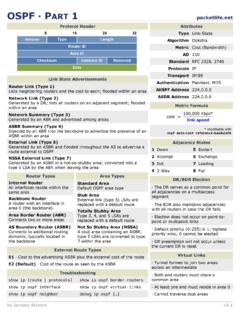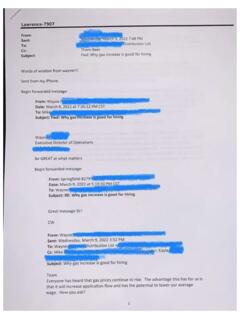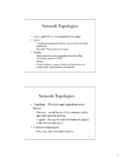Transcription of Questionnaire Design: The Backbone of Reseach
1 Questionnaire DESIGN A working paper to be discussed on June 5, 2010 by Bidhan Acharya Associate Professor Central Department of Population Studies Tribhuvan University For a Training cum-Workshop in Research Methodology Organised by Centre for Post-graduate Studies Nepal Engineering College in Collaboration with University Grants Commission Nepal Sanothimi, Bhaktapur ** Pulchok, Lalitpur, Nepal 2-11 June 2010 Enumerators in Dhanusha in Exercise for Filling in the Questionnaire of Social Exclusion Survey of CNAS, TU 1 TABLE OF CONTENTS 1. General Background .. 2 2. Types of Questionnaire .. 2 : Content of Questions.
2 3 : Type of Questions .. 3 Close ended and Open ended .. 3 Scaling type of questions .. 4 Matrix type of Questions .. 6 Ranking type of questions .. 6 Caution: Rank and Category .. 7 3: Construct of 7 4. Pre-coded questions .. 7 5. Retrieval of the Events .. 8 6. Language of the Questions .. 8 : Eleven No s in question designing.. 9 1. No question without objective: .. 9 2. No complex language: .. 9 3. No ambiguous concepts: .. 9 4. No leading and embarrassing questions (Wording, Leading and threatening): .. 9 5. No shorter checklist (Response Set): .. 9 6. No longer questions: .. 9 7. No 2 in 1: .. 10 8. No double negative (Double barrelled).
3 10 9. No calculations: .. 10 10. No longer and vague reference periods: .. 10 11. No reference of previous questions: .. 10 7. Sequence and Skipping .. 10 : Funnel and inverted funnel sequence .. 11 8. Texts, Clarifications and Instructions .. 12 9. Layout of Questionnaire .. 12 10. Questionnaire Administration .. 13 11. Reliability Instruments .. 13 Question of Reliability while Questionnaire Designing .. 13 12. Conclusion .. 14 Suggested Readings .. 14 2 Types of Questionnaire Structured Unstructured Quasi-structured Questionnaire DESIGN Bidhan Acharya 1. General Background Most of the social science researches are based on the information provided by the target population chosen for the analyses.
4 How to determine target or sample population is normally the part of discussion in sampling design. This paper discusses on the essentials of the Questionnaire construction. Questionnaire design is very crucial and important part of the research, because an inappropriate Questionnaire misleads the research, academics and policymaking. Therefore, a set of adequate and appropriate questions in a sequential order is required in a Questionnaire . A Questionnaire is defined as a document containing questions and other types of items designed to solicit information appropriate to analysis (Babbie, 1990:377).
5 Questionnaire is equally used in survey research, experiments and other modes of observation. Indeed, people ask different questions in their daily life to satisfy their queries. Journalists, market researchers, observers and interested persons in different events ask a set of questions to others. They form an opinion or conclusion according to the answers that they receive. The use of the Questionnaire or a set of questions is a similar process in the research. The research questions are firmly constructed to receive answers related to the chosen variables for analysis.
6 Social science research is the basic tool to inaugurate, illustrate and predict the human behaviour. The findings of research contribute to policy making and enhancement of the academics. These findings are based on the answers collected through different questions asked to the sample population. Naturally, dubious and inconsistent questions produce ambiguous and inharmonious answers that result in futile analyses and incoherent outcome of the research. Therefore, the analyses, outcomes, general conclusions, recommended policy and identified area for future research all depend on how perfectly the Questionnaire is constructed.
7 Thus, Questionnaire construction is the most important part of the research and other information collection activities. Human behaviour is one of the most unpredictable matters in the world. People with similar social setting, same level of education and income might be different from each other in terms of average number of children they have and use and non-use of family planning methods. There are many seen and unseen issues, which guide the behaviour and differential results are observed. Researchers do need to collect information on these issues that are related to their studies.
8 Furthermore, the researches need to collect information on such issues, which are not even discussed in the groups of the people. Even the husband and wife have not discussed on the topic yet, the researchers do want to know their opinions that is expected to reflect the couple. Moreover, many issues in the life of a person, couple, household or society are abstract. They are thought as abstracts and practised as abstracts too. With the help of some sets of questions, the researchers collect information on these abstract behaviours and quantify collected information according to their own definitions.
9 The challenge to the researchers is that they have to copy human behaviour on paper in quantitative terms and analyse them as to reflect what really is happened in the society. The relevant questions are the only tool to know about human characteristics. Therefore, survey questionnaires are also termed as structured in through quantifiable information is collected and analysed. 2. Types of Questionnaire There are roughly two types of questionnaires, structured and unstructured. A mixture of these both is the quasi-structured Questionnaire that is used mostly in social science research.
10 3 Structured questionnaires include pre-coded questions with well-defined skipping patterns to follow the sequence of questions. Most of the quantitative data collection operations use structured questionnaires. Advantages of such structured questionnaires are - less discrepancies, easy to administer, consistency in answers and easy for the data management. Unstructured questionnaires include open ended and vague opinion-type questions. Maybe questions are not in the format of interrogative sentences and moderator or the enumerator has to elaborate the sense of question. Focus group discussions use such Questionnaire .








